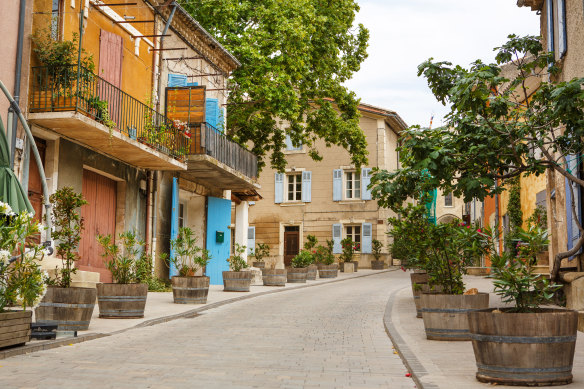
We are travelling with two children, seven and 11, to France and Italy over three weeks, starting and ending in Paris. We would like to spend most of our time in the countryside but where to go? And do we travel by train or plane? D. Adams, Bondi, NSW
Street scene in Saint-Remy-de-Provence – a great base for exploring the French countryside.Credit: iStock
Train travel is preferable to flying, but the only practical way to experience many of the treasures of rural France and Italy is by getting behind the wheel. Without a vehicle you’ll be confined to larger towns and cities.
An alternative is to base yourself in places that are easy to reach by train and take guided tours but with young children that’s a big ask. From Paris you might take the train south to Avignon then another train to Saint-Remy-de-Provence, a gorgeous town with heaps of character and a perfect base for exploring one of the prettiest corners of France.
Next stop, Antibes, from where you can explore France’s Mediterranean coast, followed by a few nights in Milan. Head north just a short distance to Lake Como and spend three nights at least, and somewhere between Lenno and Tremezzina, perhaps Villa Mirabella, would be ideal. From there it’s easy to get around on the lake ferries. If you’re driving, head for Tirano, on the border between Italy and Switzerland, abandon your car for the day and take the train over the Swiss Alps to St Moritz. It only takes 2½ hours each way and it’s a cracker of a ride, an engineering marvel as well as a scenic wonder, past glaciers, through forests and down the lovely Engadin Valley.
Return to Tirano, stay the night then continue to Bolzano. This pocket-sized city likes to pretend it’s still part of Austria, and its Tyrolean heritage is reflected in the local language, food and even the way the residents dress. Stay three nights at least and take a hike – this is some of the most glorious alpine scenery in all of Europe. Finally, Venice with whatever time you have left. The train back to Paris takes 12 hours, driving is about the same and this is one sector you might choose to fly if there’s no vehicle in the picture.
Hiring a car for travel in France and Spain you need a Crit’Air label. To obtain one, you need to know the registration of your vehicle beforehand which is impossible for a rental. How do you get an appropriate sticker? J. Taylor, Point Cook, Vic
The Crit’Air sticker is now required to enter the Low Emission Zones (LEZ) in many French cities. From 2025, all cities with populations of more than 150,000 will be required to introduce an LEZ. If you’re hiring from France, your car-hire operator should provide a Crit’Air sticker.
You need to check this before you lock in your booking since it is only the registered owner of the vehicle who can apply for the sticker and the fine for non-compliance is €68 ($112), rising to €750 ($1239) once camera-based enforcement begins. All major cities in Spain also operate LEZs however the French Crit’Air sticker is valid in those cities. The exception is Barcelona, which does not recognise foreign environmental stickers.
My husband and I are planning a road trip through South Australia over three to four weeks in April next year. We do not propose driving more than 300 kilometres a day and would like to see some of the silo art, enjoy beautiful landscapes, embark on walking trails in national parks and revel in good pub meals. S. Chee, Brighton, Vic
Source: watoday.com.au

George Barham, an accomplished journalist and avid gambling enthusiast, serves as the esteemed Editor-in-Chief at fly-to-australia.com, Australia’s leading source for comprehensive gambling news and insights. With an unwavering passion for both the written word and the ever-evolving world of betting and gaming, George brings a wealth of knowledge and expertise to the helm of our editorial team.




